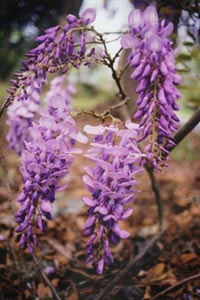Wisteria
|
|
| Wisteria | ||||||||||||||||
|---|---|---|---|---|---|---|---|---|---|---|---|---|---|---|---|---|
 Flowering Wisteria | ||||||||||||||||
| Scientific classification | ||||||||||||||||
| ||||||||||||||||
| Species | ||||||||||||||||
|
See text |
This article is about the plant. For the color, see Wisteria (color)
Wisteria is a genus of about ten species of woody climbing vines native to eastern North America (United States) and east Asia (China, Korea, Japan). The vines climb by twining their entire stems either clockwise (As in Wisteria floribunda) or counter-clockwise (Wisteria sinensis) round any available support. They can climb as high as 20m above ground and spread at least half that far laterally.
The leaves are alternate, 15-35 cm long, pinnate, with 9-19 leaflets. The flowers are produced in pendulous racemes 10-80 cm long, similar to those of genus Laburnum, but purple, violet, pink or white, not yellow. Flowering is in the spring (just before or as the leaves open) in some Asian species, and in mid to late summer in the American species and W. japonica. The flowers of some species are fragrant, most notably Wisteria sinensis. The seeds are produced in pods similar to those of laburnum, and, like that genus, are poisonous.
The genus was named after Dr. Caspar Wistar (1761-1818), a professor of anatomy at the University of Pennsylvania. As a consequence, the name is sometimes given as "Wistaria", but the spelling Wisteria is conserved under the International Code of Botanical Nomenclature.
Species
- Wisteria brachybotrys
- Wisteria floribunda - Japanese Wisteria
- Wisteria frutescens - American Wisteria
- Wisteria japonica
- Wisteria macrostachya - Kentucky Wisteria
- Wisteria sinensis - Chinese Wisteria
- Wisteria venusta - Silky Wisteria
- Wisteria villosa
Cultivation
Wisteria, especially Wisteria sinensis, is very hardy and fast-growing. It can grow in fairly poor--quality soils but prefers fertile, moist, well-drained ones. It thrives in full sun to partial shade.
Wisteria can be propogated via hardwood cutting, softwood cuttings, or seed. However, seeded specimens can take decades to bloom; for that reason it is best to only grow plants that have been started from rooted cuttings or grafted cultivars known to flower well. Another reason for failure to bloom can be excessive fertilizer (particularly nitrogen). Wisteria has nitrogen fixing capability and thus mature plants may benefit from added potassium and phosphate but not nitrogen. Finally, wisteria can be reluctant to bloom because it has not reached maturity. Maturation may require only a few years as in Kentucky Wisteria or nearly twenty as in Chinese Wisteria. Maturation, can be forced by physically abusing the main trunk, root pruning, or drought stress.
Wisteria can grow into an unattractive mound when unsupported but is at its best when allowed to clambor up a tree, pergola, wall, or other supporting structure. Whatever the case, the support must be strong indeed for old wisteria can grow into immensely strong and heavy wrist-thick trunk and stems. These will certainly rend latticework, crush thin wooden posts, and can even strangle large trees. Its pendulous racemes are best viewed from below. Wisteria is an aggressive grower which can quickly clog gutters, sometimes invade foundations, and cause other physical damage if not controlled. To avoid many of these problems, wisteria should not be planted near a dwelling.
Wisteria flowers develop in buds near the base of the previous year's growth, so pruning back side shoots to the basal few buds in early spring can enhance the visibility of the flowers. If it is desired to control the size of the plant, the side shoots can be shortened to 20-40 cm long in mid summer, and back to 10-20 cm in the fall.
